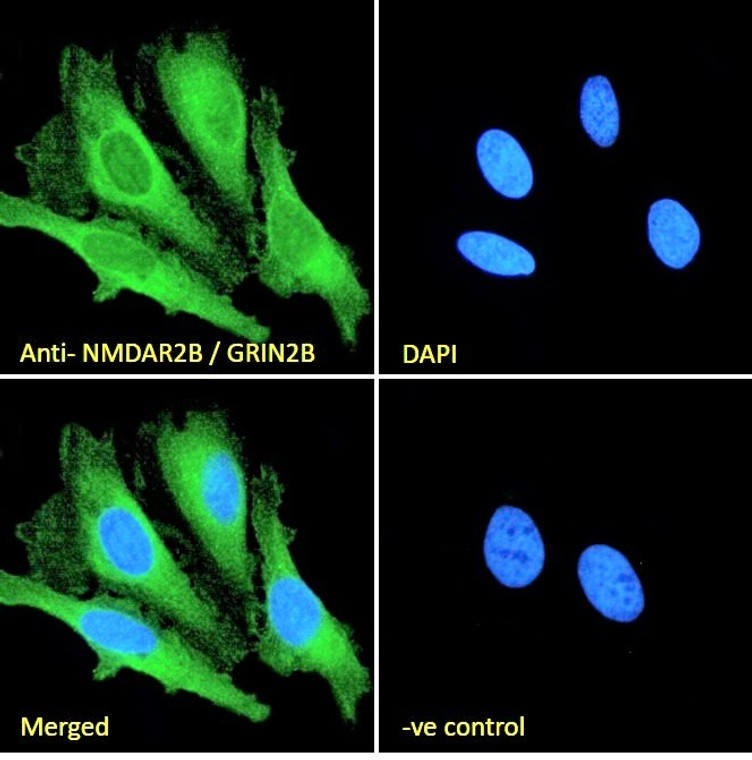| Host: |
Goat |
| Applications: |
Pep-ELISA/WB/IF |
| Reactivity: |
Human/Mouse/Rat/Dog |
| Note: |
STRICTLY FOR FURTHER SCIENTIFIC RESEARCH USE ONLY (RUO). MUST NOT TO BE USED IN DIAGNOSTIC OR THERAPEUTIC APPLICATIONS. |
| Short Description: |
Goat polyclonal antibody anti-NMDAR2B/GRIN2B (Internal) is suitable for use in ELISA, Western Blot and Immunofluorescence research applications. |
| Clonality: |
Polyclonal |
| Conjugation: |
Unconjugated |
| Isotype: |
IgG |
| Formulation: |
0.5 mg/ml in Tris saline, 0.02% sodium azide, pH7.3 with 0.5% bovine serum albumin. NA |
| Purification: |
Purified from goat serum by ammonium sulphate precipitation followed by antigen affinity chromatography using the immunizing peptide. |
| Concentration: |
0.5 mg/mL |
| Dilution Range: |
WB-2-4µg/mlELISA-antibody detection limit dilution 1:16000. |
| Storage Instruction: |
Store at-20°C on receipt and minimise freeze-thaw cycles. |
| Gene Symbol: |
GRIN2B |
| Gene ID: |
2904 |
| Uniprot ID: |
NMDE2_HUMAN |
| Immunogen Region: |
Internal |
| Accession Number: |
NP_000825.1 |
| Immunogen Sequence: |
KDAHEKDDFHHLS |
| Post Translational Modifications | Phosphorylated on tyrosine residues. Phosphorylation at Ser-1303 by DAPK1 enhances synaptic NMDA receptor channel activity. |
| Function | Component of NMDA receptor complexes that function as heterotetrameric, ligand-gated ion channels with high calcium permeability and voltage-dependent sensitivity to magnesium. Channel activation requires binding of the neurotransmitter glutamate to the epsilon subunit, glycine binding to the zeta subunit, plus membrane depolarization to eliminate channel inhibition by Mg(2+). Sensitivity to glutamate and channel kinetics depend on the subunit composition. In concert with DAPK1 at extrasynaptic sites, acts as a central mediator for stroke damage. Its phosphorylation at Ser-1303 by DAPK1 enhances synaptic NMDA receptor channel activity inducing injurious Ca2+ influx through them, resulting in an irreversible neuronal death. Contributes to neural pattern formation in the developing brain. Plays a role in long-term depression (LTD) of hippocampus membrane currents and in synaptic plasticity. |
| Protein Name | Glutamate Receptor Ionotropic - Nmda 2bGlun2bGlutamate Nmda Receptor Subunit Epsilon-2N-Methyl D-Aspartate Receptor Subtype 2bNmdar2bNr2bN-Methyl-D-Aspartate Receptor Subunit 3Nr3Hnr3 |
| Database Links | Reactome: R-HSA-3928662Reactome: R-HSA-438066Reactome: R-HSA-442982Reactome: R-HSA-5673001Reactome: R-HSA-6794361Reactome: R-HSA-8849932Reactome: R-HSA-9022699Reactome: R-HSA-9032500Reactome: R-HSA-9609736Reactome: R-HSA-9617324Reactome: R-HSA-9620244 |
| Cellular Localisation | Cell MembraneMulti-Pass Membrane ProteinPostsynaptic Cell MembraneLate EndosomeLysosomeCytoplasmCytoskeletonCo-Localizes With The Motor Protein Kif17 Along Microtubules |
| Alternative Antibody Names | Anti-Glutamate Receptor Ionotropic - Nmda 2b antibodyAnti-Glun2b antibodyAnti-Glutamate Nmda Receptor Subunit Epsilon-2 antibodyAnti-N-Methyl D-Aspartate Receptor Subtype 2b antibodyAnti-Nmdar2b antibodyAnti-Nr2b antibodyAnti-N-Methyl-D-Aspartate Receptor Subunit 3 antibodyAnti-Nr3 antibodyAnti-Hnr3 antibodyAnti-GRIN2B antibodyAnti-NMDAR2B antibody |
Information sourced from Uniprot.org
12 months for antibodies. 6 months for ELISA Kits. Please see website T&Cs for further guidance








